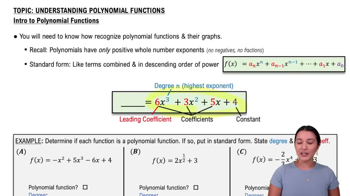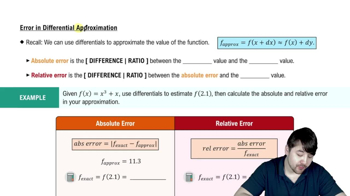Table of contents
- 0. Functions7h 52m
- Introduction to Functions16m
- Piecewise Functions10m
- Properties of Functions9m
- Common Functions1h 8m
- Transformations5m
- Combining Functions27m
- Exponent rules32m
- Exponential Functions28m
- Logarithmic Functions24m
- Properties of Logarithms34m
- Exponential & Logarithmic Equations35m
- Introduction to Trigonometric Functions38m
- Graphs of Trigonometric Functions44m
- Trigonometric Identities47m
- Inverse Trigonometric Functions48m
- 1. Limits and Continuity2h 2m
- 2. Intro to Derivatives1h 33m
- 3. Techniques of Differentiation3h 18m
- 4. Applications of Derivatives2h 38m
- 5. Graphical Applications of Derivatives6h 2m
- 6. Derivatives of Inverse, Exponential, & Logarithmic Functions2h 37m
- 7. Antiderivatives & Indefinite Integrals1h 26m
- 8. Definite Integrals4h 44m
- 9. Graphical Applications of Integrals2h 27m
- 10. Physics Applications of Integrals 2h 22m
4. Applications of Derivatives
Differentials
Problem 4.8.58c
Textbook Question
{Use of Tech} Fixed points of quadratics and quartics Let f(x) = ax(1 -x), where a is a real number and 0 ≤ a ≤ 1. Recall that the fixed point of a function is a value of x such that f(x) = x (Exercises 48–51).
c. Graph g for a = 2, 3, and 4.
 Verified step by step guidance
Verified step by step guidance1
Understand the concept of a fixed point: A fixed point of a function f(x) is a value x such that f(x) = x. This means that when you substitute x into the function, the output is the same as the input.
For the function f(x) = ax(1 - x), we need to find the fixed points by solving the equation f(x) = x. This translates to ax(1 - x) = x.
Rearrange the equation ax(1 - x) = x to find the values of x that satisfy it. Start by expanding the left side: ax - ax^2 = x.
Move all terms to one side to form a quadratic equation: ax - ax^2 - x = 0, which simplifies to (a - 1)x - ax^2 = 0.
Factor the quadratic equation or use the quadratic formula to find the values of x. The solutions to this equation will be the fixed points of the function for the given values of a.
 Verified video answer for a similar problem:
Verified video answer for a similar problem:This video solution was recommended by our tutors as helpful for the problem above
Video duration:
6mPlay a video:
Was this helpful?
Key Concepts
Here are the essential concepts you must grasp in order to answer the question correctly.
Fixed Points
A fixed point of a function is a value of x where the function's output equals its input, i.e., f(x) = x. This concept is crucial for understanding the behavior of functions, as fixed points can indicate stable or unstable equilibria. In the context of the given function f(x) = ax(1 - x), finding fixed points involves solving the equation ax(1 - x) = x.
Recommended video:

Critical Points
Quadratic Functions
Quadratic functions are polynomial functions of degree two, typically expressed in the form f(x) = ax^2 + bx + c. The function provided, f(x) = ax(1 - x), can be rewritten as f(x) = -ax^2 + ax, which is a quadratic function. Understanding the properties of quadratics, such as their parabolas' shapes and vertex locations, is essential for graphing and analyzing the function's behavior.
Recommended video:

Introduction to Polynomial Functions
Graphing Techniques
Graphing techniques involve plotting points and understanding the shape and behavior of functions on a coordinate plane. For the function f(x) = ax(1 - x), varying the parameter 'a' affects the width and position of the parabola. When graphing for different values of 'a' (2, 3, and 4), one must consider how these changes influence the fixed points and overall graph shape, which is vital for visualizing the function's dynamics.
Recommended video:

Graphing The Derivative







